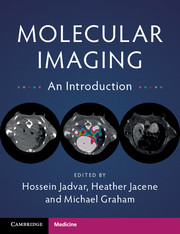Book contents
- Frontmatter
- Contents
- List of Contributors
- Preface
- 1 Instrumentation – CT
- 2 MRI/ MRS Instrumentation and Physics
- 3 Optical and Ultrasound Imaging
- 4 Instrumentation-Nuclear Medicine and PET
- 5 Quantitation-Nuclear Medicine
- 6 Perfusion
- 7 Metabolism
- 8 Cellular Proliferation
- 9 Hypoxia
- 10 Receptor Imaging
- 11 Apoptosis
- 12 Angiogenesis
- 13 Reporter Genes
- 14 Stem Cell Tracking
- 15 Amyloid Imaging
- Index
- References
10 - Receptor Imaging
Published online by Cambridge University Press: 22 November 2017
- Frontmatter
- Contents
- List of Contributors
- Preface
- 1 Instrumentation – CT
- 2 MRI/ MRS Instrumentation and Physics
- 3 Optical and Ultrasound Imaging
- 4 Instrumentation-Nuclear Medicine and PET
- 5 Quantitation-Nuclear Medicine
- 6 Perfusion
- 7 Metabolism
- 8 Cellular Proliferation
- 9 Hypoxia
- 10 Receptor Imaging
- 11 Apoptosis
- 12 Angiogenesis
- 13 Reporter Genes
- 14 Stem Cell Tracking
- 15 Amyloid Imaging
- Index
- References
Summary
Cell surface receptors and their associated receptor ligands are fundamental and essential aspects of the physiology and homeostasis of virtually all multi-cellular organisms. In addition, many tumors have either unique receptors or have significantly up-regulated receptors that can be exploited for both diagnosis and therapy. There are currently several approved radiopharmaceuticals that are available, as well as a major amount of research going into the development of new receptor-based imaging agents. The currently available agents are listed in Table 10.1.
The obvious key approach for receptor imaging is to identify a ligand that binds to the receptor and that can be imaged. This usually involves an imaging entity, a linker, and the binding ligand, see Figure 10.1.
There are several considerations that must be taken into account in the selection of specific ligands, linkers, and labels for different situations. Some of the most important general considerations in selecting a specific combination are metabolic stability, in-vivo pharmacokinetics, and imaging label characteristics. The combined imaging agent must be metabolically stable, so that the label remains attached to the ligand. The ligand should have high receptor specificity and affinity, so that it binds to the desired receptor well and does not bind significantly elsewhere. The label should have a half-life that is compatible with the rate that the ligand binds to the receptor and clears from the background. Other considerations are discussed in the pages that follow.
Receptor Ligands
Oligopeptide Ligands
Since every receptor has to have a binding ligand, the most direct approach is to identify the endogenous or exogenous binding protein and use it in the design of a receptor imaging agent. Generally, this direct approach is not successful because of the relatively rapid metabolic degradation of endogenous ligands. For instance, somatostatin has a half-life in the circulation of only 2–3 minutes. The usual approach is to modify the endogenous ligand to decrease or block its metabolism, but at the same time preserve the receptor affinity. This approach has been used successfully for the somatostatin receptor, which can be imaged with In-111 pentetreotide. The label is In-111, the linker is di-ethylene-triamine-penta-acetic (DTPA), and the ligand is an oligopeptide consisting of eight amino acids similar to the binding part of somatostatin.
- Type
- Chapter
- Information
- Molecular ImagingAn Introduction, pp. 43 - 46Publisher: Cambridge University PressPrint publication year: 2017



